Comparative Study of Consequent-Pole Switched-Flux Machines with Different U-Shaped PM Structures
Abstract
1. Introduction
2. Machine Topologies and Analysis Models
2.1. Machine Topologies
2.2. Analytical Modelling
2.3. Torque Quantification by a Hybrid FE/Analytical Approach
3. Design Optimization
3.1. Rotor Pole Selection
3.2. Multi-Objective Optimization
4. Electromagnetic Characteristics Investigation
4.1. Open-Circuit Performance
4.2. On-Load Torque Characteristics
4.3. Loss and Efficiency Characteristics
5. Experimental Validation
6. Conclusions
- The performance comparison of two CP-SFPM machines with different U-shaped magnets was carried out, which provides a guidance design for this type of machine.
- A hybrid FE/analytical model for elaborating the torque production mechanism of the investigated machines, as well as comprehensive comparative analyses, are presented, which can clearly identify the dominant air-gap field harmonics contributing to the torque production, as well as reveal the underlying reason why model-II topology can deliver the higher torque capability of the two U-shaped PM designs.
- The electromagnetic characteristics of the two optimized CP-SFPM machines were comparatively investigated. It can be found that model-II exhibits s higher torque capability and PM utilization ratio, which are mainly attributed to higher low-order working harmonics. Moreover, model-II has a wider high-efficiency region than the model-I case, which is mainly due to its relatively lower iron loss and PM eddy-current loss. Therefore, the CP-SFPM machine with model-II structure exhibits a more potential practical EV application than the model-I case.
Author Contributions
Funding
Conflicts of Interest
References
- Sarigiannidis, A.G.; Beniakar, M.E.; Kladas, A.G. Fast adaptive evolutionary PM traction motor optimization based on electric vehicle drive cycle. IEEE Tran. Veh. Tech. 2017, 66, 5762–5774. [Google Scholar] [CrossRef]
- Reddy, P.B.; El-Refaie, A.M.; Huh, K.K.; Tangudu, J.K.; Jahns, T.M. Comparison of interior and surface PM machines equipped with fractional-slot concentrated windings for hybrid traction applications. IEEE Trans. Energy Convers. 2012, 27, 593–602. [Google Scholar] [CrossRef]
- Burress, T.A.; Campbell, S.L.; Coomer, C.L. Evaluation of the 2010 Toyota Prius Hybrid Synergy Drive System; Oak Ridge National Lab.: Oak Ridge, TN, USA, 2010; pp. 1–88. [Google Scholar]
- Momen, F.; Rahman, K.; Son, Y. Electrical propulsion system design of chevrolet bolt battery electric vehicle. IEEE Trans. Ind. Appl. 2019, 55, 376–384. [Google Scholar] [CrossRef]
- Yamazaki, K.; Kumagzi, M.; Ikemi, T.; Ohki, S. A novel rotor design of interior permanent-magnet synchronous motors to cope with both maximum torque and iron-loss reduction. IEEE Trans. Ind. Appl. 2014, 49, 2478–2486. [Google Scholar] [CrossRef]
- Boldea, I.; Tutelea, L.; Pitic, C.I. PM-assisted reluctance synchronous motor/generator (PM-RSM) for mild hybrid vehicles: Electromagnetic design. IEEE Trans. Ind. Appl. 2004, 40, 492–498. [Google Scholar] [CrossRef]
- Ramesh, P.; Lenin, N.C. High power density electrical machines for electric vehicles—comprehensive review based on material technology. IEEE Trans. Magn. 2019, 55, 0900121. [Google Scholar] [CrossRef]
- Li, D.; Qu, R.; Xu, W.; Li, J.; Lipo, T.A. Design procedure of dual-stator spoke-array vernier permanent-magnet machines. IEEE Trans. Ind. Appl. 2015, 51, 2972–2983. [Google Scholar] [CrossRef]
- Zhao, W.; Chen, D.; Lipo, T.A.; Kwon, B. Dual air-gap stator- and rotor-permanent magnet machines with spoke-type configurations using phase-group concentrated coil windings. IEEE Trans. Ind. Appl. 2017, 53, 3327–3335. [Google Scholar] [CrossRef]
- Zhang, H.; Hua, W.; Wu, Z.; Zhu, X. Design considerations of novel modular-spoke-type permanent magnet machines. IEEE Trans. Ind. Appl. 2018, 54, 4236–4245. [Google Scholar] [CrossRef]
- Kim, S.; Park, S.; Park, T.; Cho, J.; Kim, W.; Lim, S. Investigation and experimental verification of a novel spoke-type ferrite-magnet motor for electric-vehicle traction drive applications. IEEE Trans. Ind. Electron. 2014, 61, 5763–5770. [Google Scholar]
- Kimiabeigi, M.; Widmer, J.D.; Long, R.; Gao, Y.; Goss, J.; Martin, R.; Lisle, T.; Vizan, J.M.S.; Michaelides, A.; Mecrow, B.C. On selection of rotor support material for a ferrite magnet spoke-type traction motor. IEEE Trans. Ind. Appl. 2016, 52, 2224–2233. [Google Scholar] [CrossRef]
- Galioto, S.J.; Reddy, P.B.; L-Refaie, A.M.E.; Alexander, J.P. Effect of magnet types on performance of high-speed spoke interior-permanent-magnet machines designed for traction applications. IEEE Trans. Ind. Appl. 2015, 51, 2148–2160. [Google Scholar] [CrossRef]
- L-Refaie, A.M.E.; Alexander, J.P.; Galioto, S.; Reddy, P.B.; Huh, K.K.; Bock, P.; Shen, X. Advanced high-power-density interior permanent magnet motor for traction applications. IEEE Trans. Ind. Appl. 2014, 50, 3235–3248. [Google Scholar] [CrossRef]
- Zhang, P.; Sizov, G.Y.; Ionel, D.M.; Demerdash, N.A.O. Establishing the relative merits of interior and spoke-type permanent-magnet machines with ferrite or NdFeB through systematic design optimization. IEEE Trans. Ind. Appl. 2015, 51, 2940–2948. [Google Scholar] [CrossRef][Green Version]
- Volpe, G.; Marignetti, F.; Roggia, S.; Popescu, M.; Goss, J. Modified 2-D model for 3-D rotor magnet leakage effects in PM spoke machines. IEEE Trans. Ind. Appl. 2019, 55, 3087–3096. [Google Scholar] [CrossRef]
- Carraro, E.; Bianchi, N.; Zhang, S.; Koch, M. Design and performance comparison of fractional slot concentrated windings spoke type synchronous motors with different slot-pole combinations. IEEE Trans. Ind. Appl. 2018, 54, 2276–2284. [Google Scholar] [CrossRef]
- Ge, X.; Zhu, Z.Q.; Li, J.; Chen, J. A spoke-type IPM machine with novel alternate airspace barriers and reduction of unipolar leakage flux by step-staggered rotor. IEEE Trans. Ind. Appl. 2016, 52, 4789–4797. [Google Scholar] [CrossRef]
- Zou, T.; Li, D.; Qu, R.; Jiang, D. Performance comparison of surface and spoke-type flux-modulation machines with different pole ratios. IEEE Trans. Magn. 2017, 53, 7402605. [Google Scholar] [CrossRef]
- Liu, W.; Lipo, T.A. Alternating flux barrier design of vernier ferrite magnet machine having high torque density. In Proceedings of the 2017 IEEE Electric Ship Technologies Symposium (ESTS), Arlington, VA, USA, 14–17 August 2017; pp. 445–450. [Google Scholar]
- Ren, X.; Li, D.; Qu, R.; Yu, Z.; Gao, Y. Investigation of spoke array permanent magnet vernier machine with alternate flux bridges. IEEE Trans. Energy Covers. 2018, 33, 2112–2121. [Google Scholar] [CrossRef]
- Liu, W.; Lipo, T.A. Analysis of consequent pole spoke type vernier permanent magnet machine with alternating flux barrier design. IEEE Trans. Ind. Appl. 2018, 54, 5918–5929. [Google Scholar] [CrossRef]
- Liu, W.; Lipo, T.A. A family of vernier permanent magnet machines utilizing an alternative rotor leakage flux blocking design. In Proceedings of the 2017 IEEE Energy Conversion Congress and Exposition (ECCE), Cincinnati, OH, USA, 1–5 October 2017; pp. 2461–2468. [Google Scholar]
- Gao, Y.; Li, D.; Qu, R.; Fang, H.; Ding, H.; Jing, L. Analysis of a novel consequent-pole flux switching permanent magnet machine with flux bridges in stator core. IEEE Trans. Energy Convers. 2018, 33, 2153–2162. [Google Scholar] [CrossRef]
- Liang, Z.; Gao, Y.; Li, D.; Qu, R. Investiagte of a flux switching permanent magnet machine with alternative flux bridges. In Proceedings of the 2019 IEEE Energy Conversion Congress and Exposition (ECCE), Baltimore, MD, USA, 29 September–3 October 2019; pp. 6548–6554. [Google Scholar]
- Gan, C.; Wu, J.; Shen, M.; Kong, W.; Hu, Y.; Cao, W. Investigation of short permanent magnet and stator flux bridge effect on cogging torque mitigation inFSPM machines. IEEE Trans. Energy Convers. 2018, 33, 845–855. [Google Scholar] [CrossRef]
- Li, Y.; Yang, H.; Lin, H. Investigation of torque improvement mechanism in emerging switched flux PM machines. IEEE J. Emerg. Sel. Top. Power Electron. 2020. accepted. [Google Scholar] [CrossRef]
- Fei, W.Z.; Shen, J.X. Novel permanent magnet switching-flux motors. In Proceedings of the 41st International Universities Power Engineering Conference, Newcastle-upon-Tyne, UK, 6–8 September 2006; pp. 729–733. [Google Scholar]
- Zhu, Z.Q. Switched Flux Permanent Magnet Machines- Innovation Continues. In Proceedings of the 2011 International Conference Electrical Machines and Systems (ICEMS), Beijing, China, 20–23 August 2011; pp. 1–10. [Google Scholar]
- Zhou, Y.J.; Zhu, Z.Q. Torque density and magnet usage efficiency enhancement of sandwiched switched flux permanent magnet machines using V-shaped magnets. IEEE Trans. Magn. 2013, 49, 3834–3837. [Google Scholar] [CrossRef]
- Mcfarland, J.D.; Jahns, T.M.; El-refaie, A.M. Performance and efficiency comparisons for interior PM and flux-switching PM machines with ferrite magnets for automotive traction applications. In Proceedings of the 2015 IEEE Energy Conversion Congress and Exposition (ECCE), Montreal, QC, Canada, 20–24 September 2015; pp. 6529–6536. [Google Scholar]
- Li, Y.; Yang, H.; Lin, H.; Zheng, H. Comparavtive study of advanced stator interior permanent magnet machines. In Proceedings of the International Electric Machines and Drives Conference (IEMDC), San Diego, CA, USA, 12–15 May 2019; pp. 266–272. [Google Scholar]
- Yang, H.; Li, Y.; Lin, H.; Zhu, Z.Q.; Lyu, S. Principle investigation and performance comparison of consequent-pole switched flux PM machines. IEEE Transp. Electrific. 2020. accepted. [Google Scholar] [CrossRef]
- Heller, B.; Hamata, V. Harmonic Field Effects in Induction Mmachines; Elsevier: Amsterdam, The Netherlands, 1977. [Google Scholar]
- Huang, L.R.; Zhu, Z.Q. Analysis of torque production in variable flux reluctance machines. IEEE Trans. Energy Convers. 2017, 32, 1297–1308. [Google Scholar] [CrossRef]
- Yang, H.; Zhu, Z.Q.; Lin, H.; Li, H.Y.; Lyu, S. Analysis of consequent-pole flux reversal permanent magnet machine with biased flux modulation theory. IEEE Trans. Ind. Electron. 2020, 67, 2107–2121. [Google Scholar] [CrossRef]
- Li, H.Y.; Liu, Y.; Zhu, Z.Q. Comparative study of air-gap field modulation in flux reversal and vernier permanent magnet machines. IEEE Trans. Magn. 2018, 54, 8105206. [Google Scholar] [CrossRef]
- Zhu, X.; Hua, W.; Wang, W.; Huang, W. Analysis of back-EMF in flux-reversal permanent magnet machines by air gap field modulation theory. IEEE Trans. Ind. Electron. 2019, 66, 3344–3355. [Google Scholar] [CrossRef]
- Mcfarland, J.D.; Jahns, T.M.; El-refaie, A.M. Analysis of the torque production mechanism for flux-switching permanent-magnet machines. IEEE Trans. Ind. Appl. 2015, 51, 3041–3049. [Google Scholar] [CrossRef]
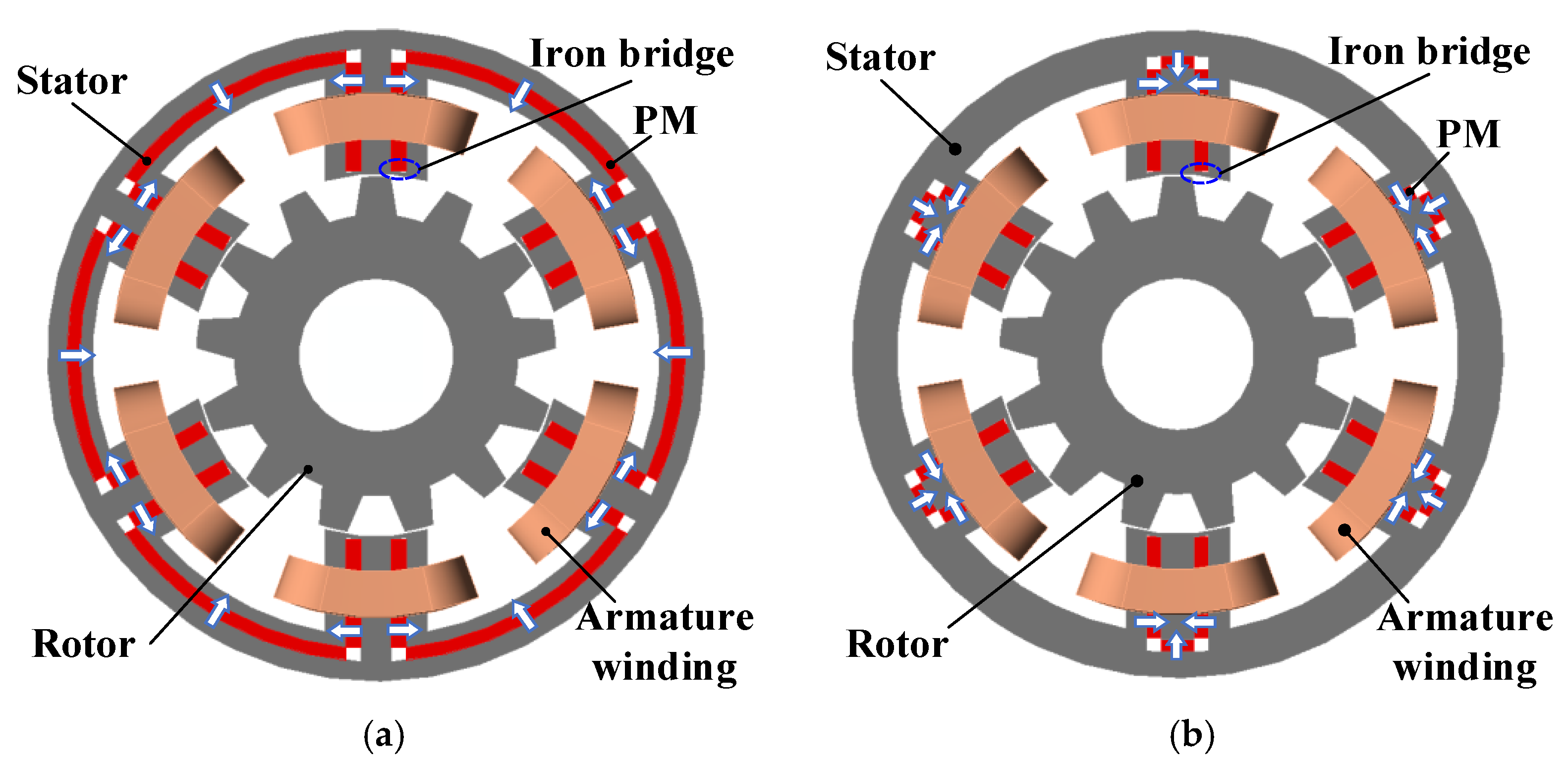


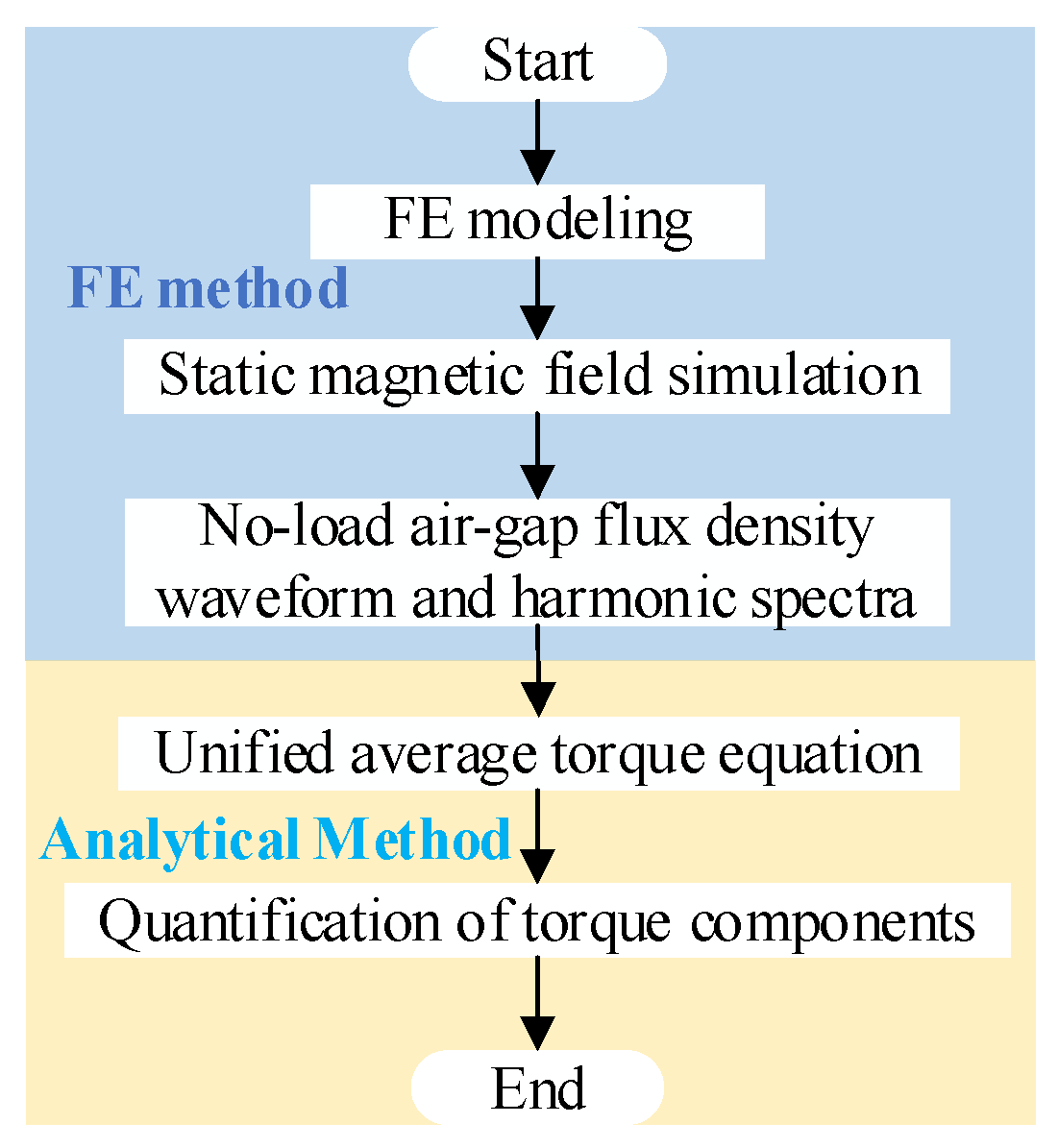

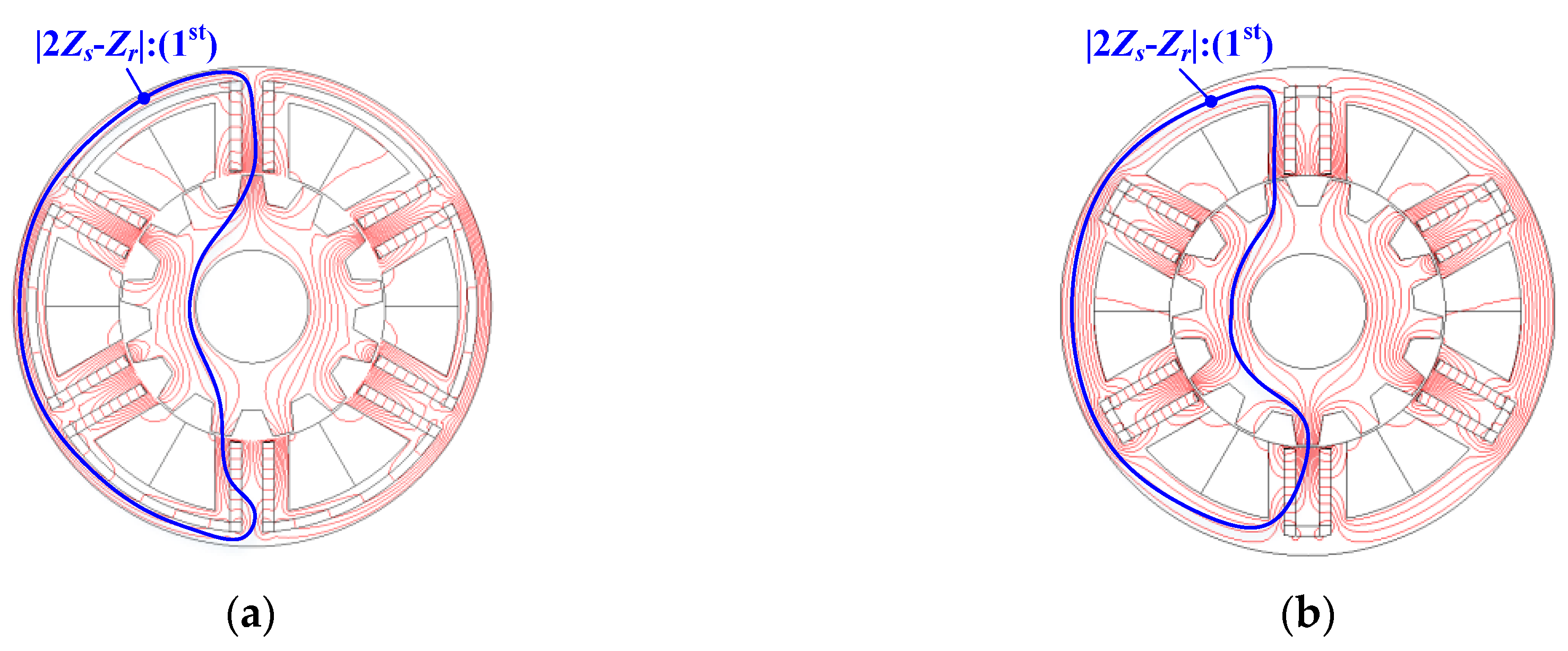


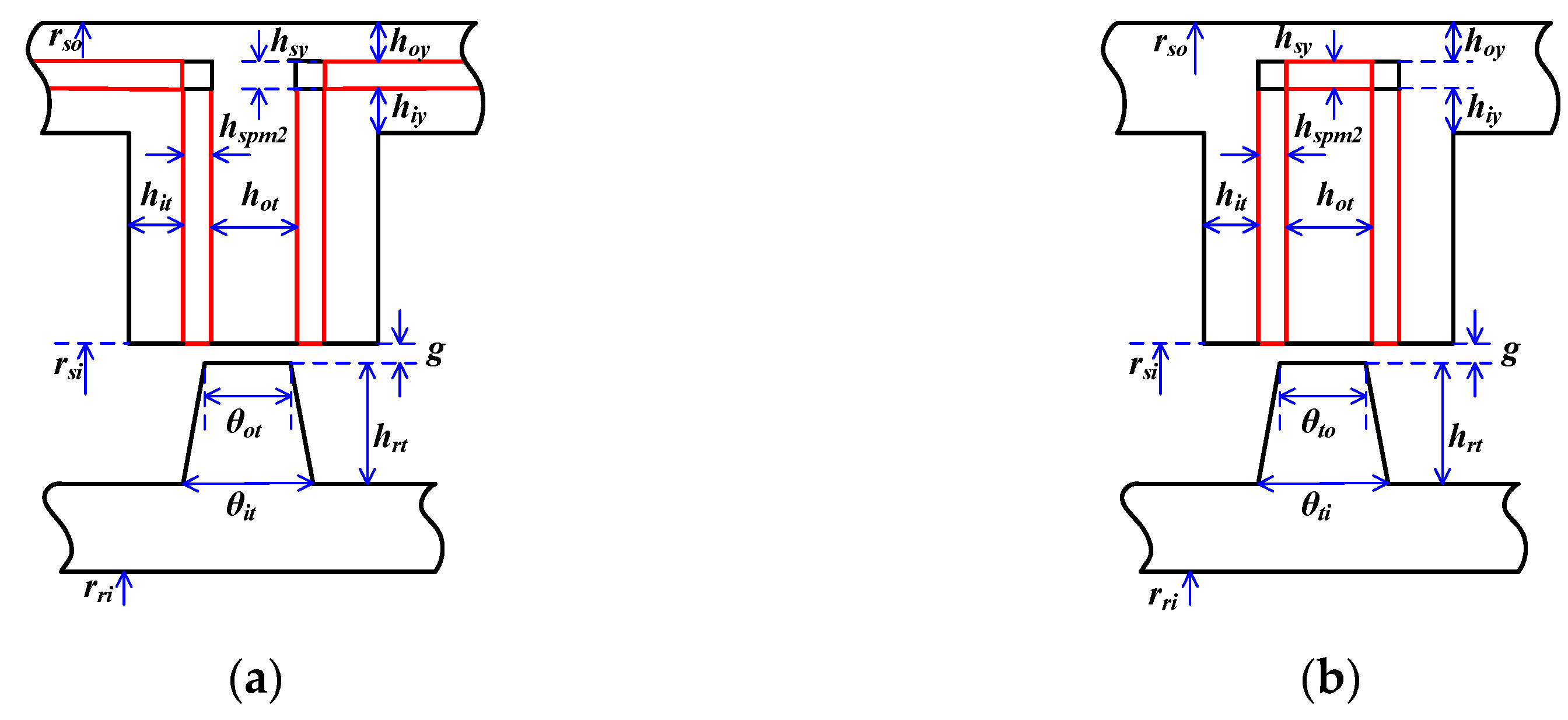


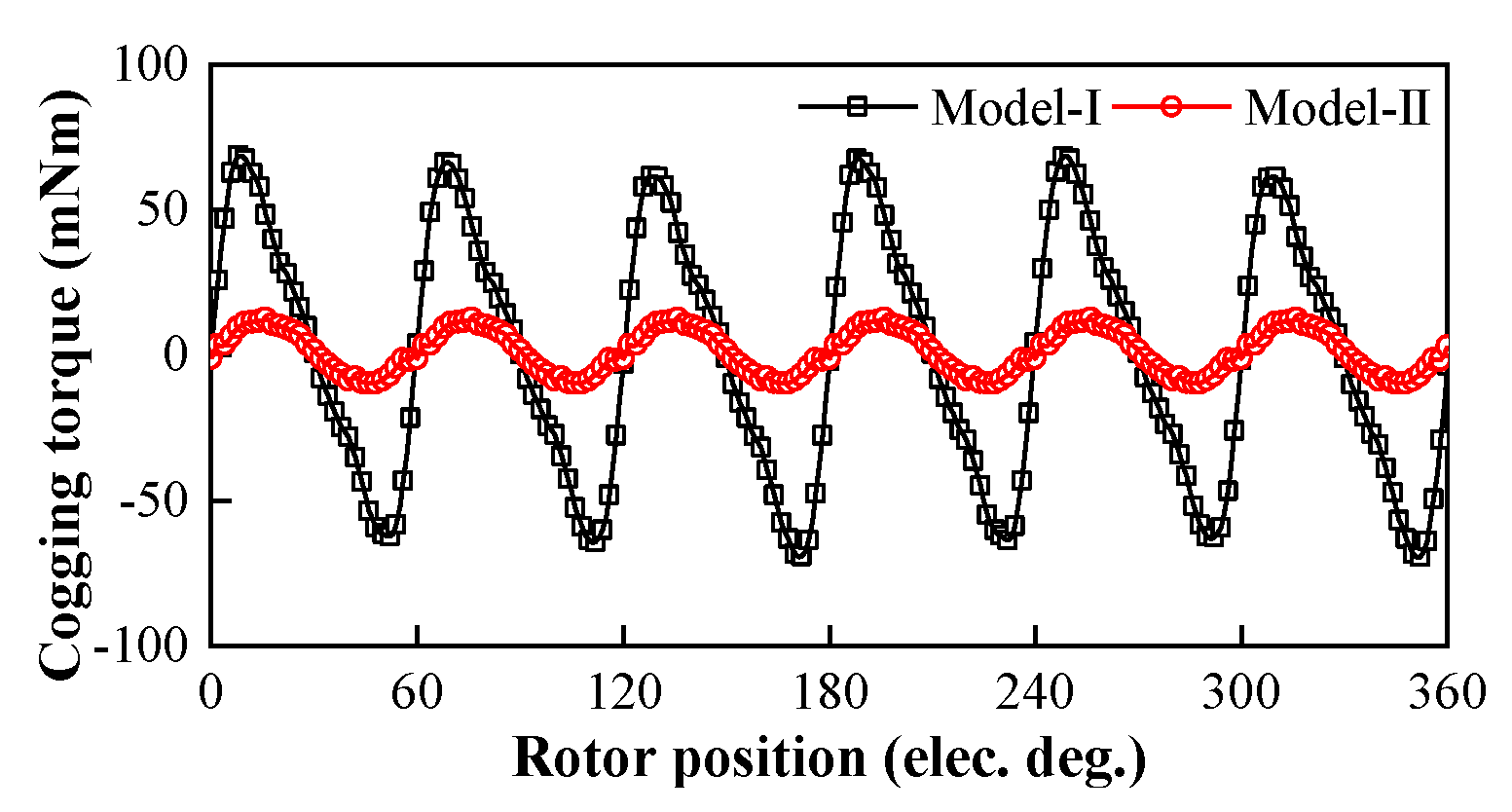


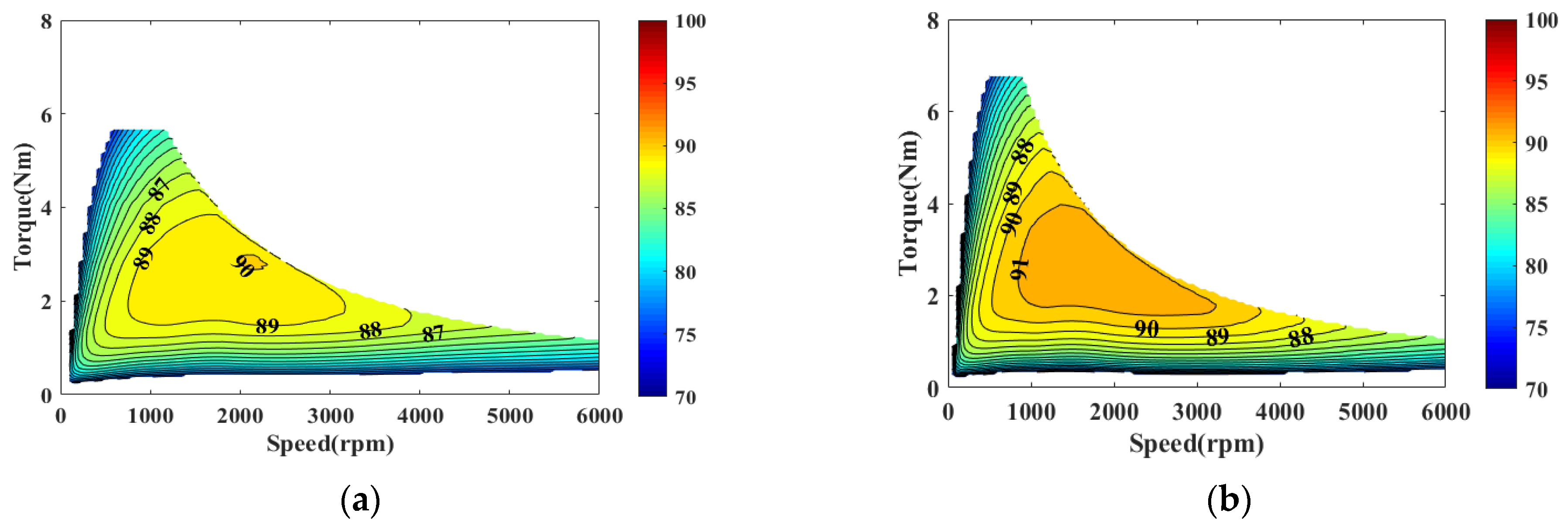
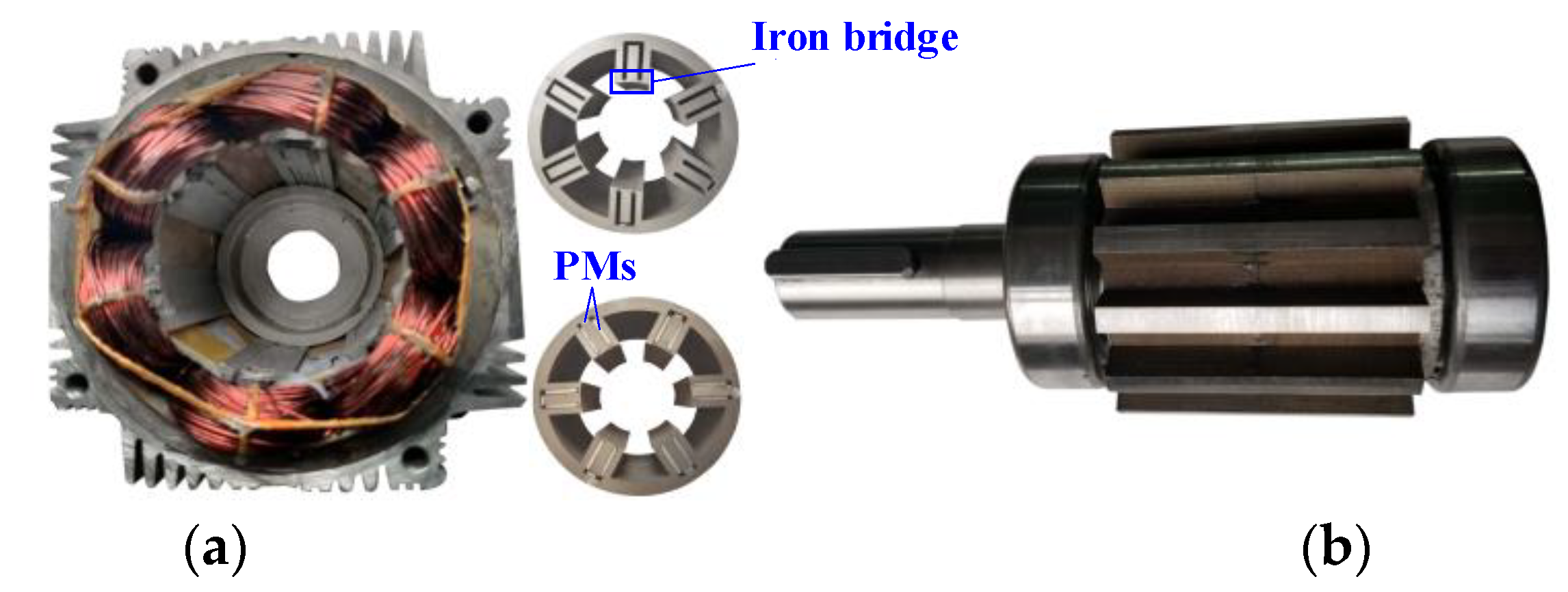


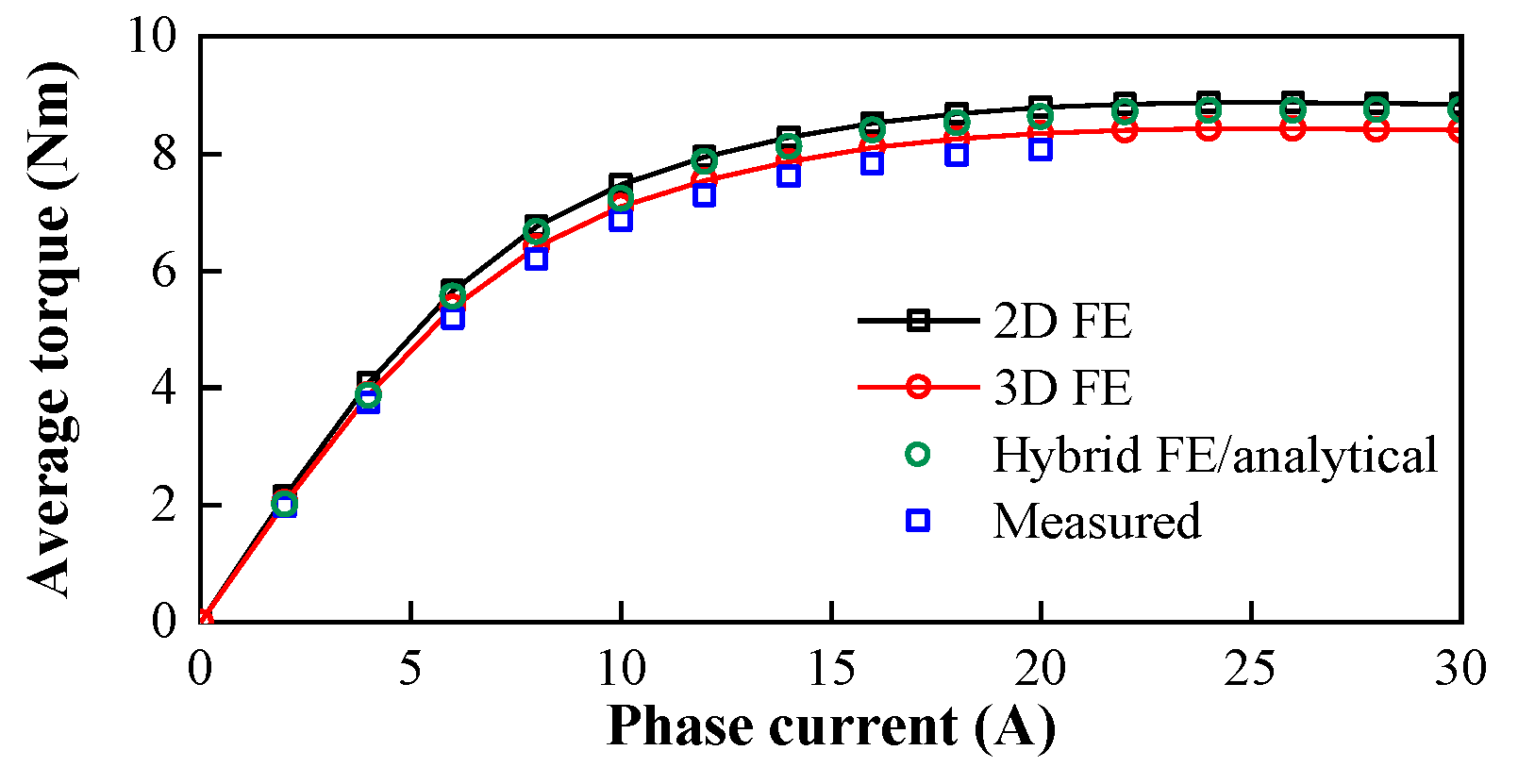

| Pole Pairs | Model-I | Model-II |
|---|---|---|
| Harmonics Magnitude (T)/Torque Contribution (Nm)/Torque Proportion (%) | ||
| |2Zs − Zr|, 1st | 0.167/4.216/75.420 | 0.204/5.274/79.189 |
| |3Zs − Zr|, 5th | 0.102/0.515/9.213 | 0.087/0.450/6.757 |
| |Zs − Zr|, 7th | 0.102/0.368/6.583 | 0.124/0.457/6.862 |
| |Zs + Zr|, 19th | 0.117/0.155/2.773 | 0.124/0.168/2.523 |
| |2Zs + Zr|, 25th | 0.201/0.203/3.631 | 0.215/0.222/3.333 |
| |3Zs + Zr|, 31th | 0.114/0.141/2.522 | 0.110/0.091/1.367 |
| Total torque | Sum (%)/FE-predicted (Nm) | |
| 5.59/5.66 | 6.66/6.74 | |
| Parameters | Model-I | Model-II |
|---|---|---|
| Stator slot number, Zs | 6 | |
| Rotor pole pairs number, Zr | 13 | |
| Stator outer diameter, rso, mm | 102 | |
| Stator inner diameter, rsi, mm | 56.8 | |
| Stator yoke PM thickness, hsy, mm | 2 | |
| Stator inner teeth thickness, hit, mm | 2.3 | |
| Stator outer teeth thickness, hot, mm | 3.2 | |
| Stator PM thickness, hspm, mm | 2.4 | |
| Iron bridge thickness, hib, mm | 0.5 | |
| Active stack length, lstk, mm | 50 | |
| Air-gap length, g, mm | 0.5 | |
| Rotor outer diameter, rro, mm | 55.8 | |
| Rotor teeth outer arc, θto, deg | 9.2 | |
| Rotor teeth inner arc, θti, deg | 16.9 | |
| Rotor teeth length, hrt, mm | 5.9 | |
| Rotor inner diameter, rri, mm | 24 | |
| PM grade | N42SH | |
| PM volume, mL | 43.37 | 25.96 |
| Steel grade | 35CS250 | |
| Turns per phase | 130 | |
| Rated current, A | 8 | |
| Items | CP-SFPM Machines | ||
|---|---|---|---|
| Model-I | Model-II | ||
| Iron loss, W | rotor | 8.93 | 8.48 |
| stator | 14.87 | 13.69 | |
| PM eddy-current loss, W | 5.63 | 1.01 | |
| Copper loss, W | 43.46 | ||
| Total loss, W | 72.89 | 66.65 | |
| Maximum efficiency, (%) | 90.03 | 91.67 | |
| Items | CP-SFPM Machines | ||
|---|---|---|---|
| Irms = 4 A | Irms = 8 A | Irms = 12 A | |
| 2D FE, (Nm) | 4.09 | 6.75 | 7.94 |
| 3D FE, (Nm) | 3.89 | 6.42 | 7.54 |
| Hybrid FE/analytical, (Nm) | 3.87 | 6.66 | 7.86 |
| Measured, (Nm) | 3.75 | 6.20 | 7.29 |
Publisher’s Note: MDPI stays neutral with regard to jurisdictional claims in published maps and institutional affiliations. |
© 2021 by the authors. Licensee MDPI, Basel, Switzerland. This article is an open access article distributed under the terms and conditions of the Creative Commons Attribution (CC BY) license (http://creativecommons.org/licenses/by/4.0/).
Share and Cite
Li, Y.; Yang, H.; Lin, H. Comparative Study of Consequent-Pole Switched-Flux Machines with Different U-Shaped PM Structures. World Electr. Veh. J. 2021, 12, 22. https://doi.org/10.3390/wevj12010022
Li Y, Yang H, Lin H. Comparative Study of Consequent-Pole Switched-Flux Machines with Different U-Shaped PM Structures. World Electric Vehicle Journal. 2021; 12(1):22. https://doi.org/10.3390/wevj12010022
Chicago/Turabian StyleLi, Ya, Hui Yang, and Heyun Lin. 2021. "Comparative Study of Consequent-Pole Switched-Flux Machines with Different U-Shaped PM Structures" World Electric Vehicle Journal 12, no. 1: 22. https://doi.org/10.3390/wevj12010022
APA StyleLi, Y., Yang, H., & Lin, H. (2021). Comparative Study of Consequent-Pole Switched-Flux Machines with Different U-Shaped PM Structures. World Electric Vehicle Journal, 12(1), 22. https://doi.org/10.3390/wevj12010022






